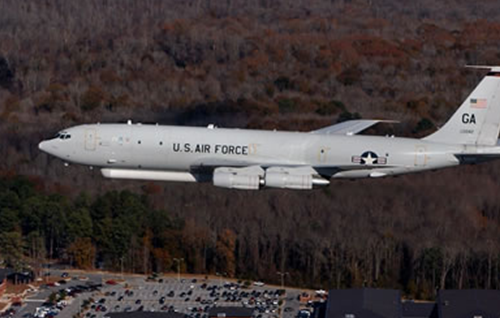

The aircraft's crew ultimately keeps ground troops safer by communicating with convoys and directing air power to quell the enemy.
The Joint Surveillance and Target Attack Radar System mission has two parts. The first is to radio relay with convoys throughout Iraq. Through radio and a text-messaging system, convoys can contact Joint STARS for help.
Air National Guard Maj. Thomas Grabowski, senior director on the aircraft, deployed from Robins Air Force Base, Ga. He said the Joint STARS is the 911 call for convoys on the ground.
“So if one of these convoys gets in trouble -- they break down, they have troops in contact, small-arms fire or any type of a problem -- they call us,” Major Grabowski said. “We’re like the ‘On-Star’ for the ground commander.”
The second part of the mission is to deter insurgent activity on Iraq’s borders. Junior enlisted Airmen are in charge of the multimillion dollar radar attached to the bottom of the aircraft that zeros in on the enemy 100 to 200 miles away. Major Grabowski said the advanced system allows them to see the enemy without the enemy seeing them.
“Think about where you live at home and then think of a place 125 miles from that location. If you were to move out of your driveway and we were orbiting 125 miles away, we would see you move. So it’s that advanced,” the major said.
Joint STARS is truly a joint mission aircraft with Army, Air Force and Marine aircrew members. Air National Guard Airmen add total force flavor as well. Army Maj. Clifton Hughes, deputy mission crew commander, is also deployed from Robins. He said he works closely with Major Grabowski and the other Air Force folks on every Joint STARS mission.
“While the Army and Marines are keeping in close contact with convoy commanders, I can then coordinate with the Joint STARS Air Force assets on the aircraft to direct air support either as a show of force or to take out the enemy,” he said.
A typical mission can last from 10 to 20 hours in flight after refueling in the air. The aircraft brings such a capability to the fight that many convoys won’t go out on the road unless Joint STARS is airborne.
A total of $300 million worth of technology goes into this aircraft. What comes out is full-spectrum dominance and reconnaissance capability that ensures peace of mind to U.S. forces on the ground that someone is always watching their backs.



















